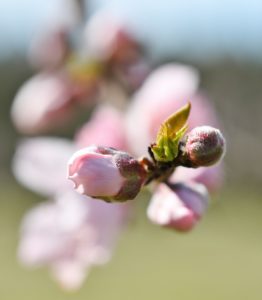Window to plant trees ends in late February
AgriLife Extension offers advice on healthy tree establishment
Prime planting season for fruit and shade trees – January to late February – is nearing the end for much of Texas, according to a Texas A&M AgriLife Extension Service expert.
Larry Stein, Ph.D., AgriLife Extension fruit specialist, Uvalde, said trees should be planted as soon as possible to allow them time to establish roots before springtime.
There is wide range of fruit
trees and vines homeowners and prospective orchardist can plant in Texas, he said. Despite the options, peach
trees are king in Texas.

“Fruit stands with no peaches attract limited traffic,” Stein said. “They’re just the most popular fruit tree for commercial and backyard growers, and there are good varieties for most locations around the state.”
Blackberries, though technically a bush, are a relatively low-maintenance fruit option, and plums and pears are also popular around the state, Stein said. Some backyard growers also plant apples, but they are not recommended because trees perform better in cooler temperatures.
Fruit tree location and variety
Choosing the right fruit variety is key to tree performance, Stein said. Chilling requirements for peaches, for instance, will determine whether the tree would perform well near San Antonio or Dallas. An early blooming variety planted in northern regions of the state would be susceptible to spring freezes.
On the other hand, if trees don’t get enough chill-hours they struggle to break dormancy and bloom, he said. Under those conditions, trees can abort fruit and successive seasons of too few chill hours can kill trees.
Stein also recommends planting bare-root trees, but cautioned that roots can freeze or dry out if not handled properly.
They should also be planted in soil that drains well, he noted.
Stein said heavy spring and late-summer rains can cause problems without adequate drainage. Standing water from heavy rains can kill peach trees in 24 hours in the middle of summer.
“Choosing the right variety is important and making sure there is good drainage is half the battle when it comes to fruit trees,” he said. “Getting those two things right greatly increases the chances of success.”
Choose trees carefully
There are a number of options for fruit variety, disease resistance, chill hours, taste and, in the case of blackberries, thorns versus thornless. But choosing the right plant after making those decisions is important.
The biggest preplanting challenge after picking the right variety is choosing the right tree, Stein said. Looking for a few signs of a stressed or sickly tree could save time and money.
Visiting a reputable nursery is a good way to avoid trees that might be carrying disease or are stressed, he said.
Dried, brown roots are a bad sign. Make sure the roots are a healthy white and have adequate moisture in them.
Check the trunk for gum oozing from it, Stein said. This can be a sign of stress, disease, pests or other damage.
Select a tree that is still dormant and isn’t budding out because a late frost can damage it, he said.
“Giving the tree a good look over for potential problems is a good idea, no matter where you buy them from,” he said. “Some are just in better shape than others, and starting with a good, healthy tree greatly increases the chance of it getting off to a good start.”
Weeds, water and fertilizer
Two things will help a newly planted tree establish and survive the first year – the right amount of water and removing weeds around it.
A post-planting key to keep newly planted trees alive and well is maintaining a weed-free area around them until they are mature, Stein said. He recommends keeping a 3-foot diameter circle around the tree clear for the first year. Herbicides are the recommended method of weed removal.
Stein said weeds should be removed to the drip line of the tree as it grows up to year four or five.
“By weeding, you’re removing the competition for moisture and nutrients the tree needs,” he said. “They will do better without that competition.”
Stein said newly planted fruit trees should receive 1 inch of water per week once they begin actively growing. But be careful not to overwater or saturate the ground.
Fertilizer is unnecessary at planting, Stein said. But if the tree has grown 8-10 inches by May, he recommends giving it 1 cup of 21% ammonium sulfate fertilizer. Users should adjust the amount if using low-nitrogen organic fertilizer, such as 3% to reach the 21% mark, or 7 cups. Water in the fertilizer.
Get off to a good start
Stein said growing and maintaining fruit trees has its challenges but establishing them is straightforward. Contact the nearest AgriLife Extension office for more specific instructions regarding varieties that would perform well locally.
“Following the simple procedure outlined above will greatly increase the chance of getting your fruit trees established and off to a good start; namely well drained soil, healthy trees, and most important of all, a weed free area around the trees,” he said.


